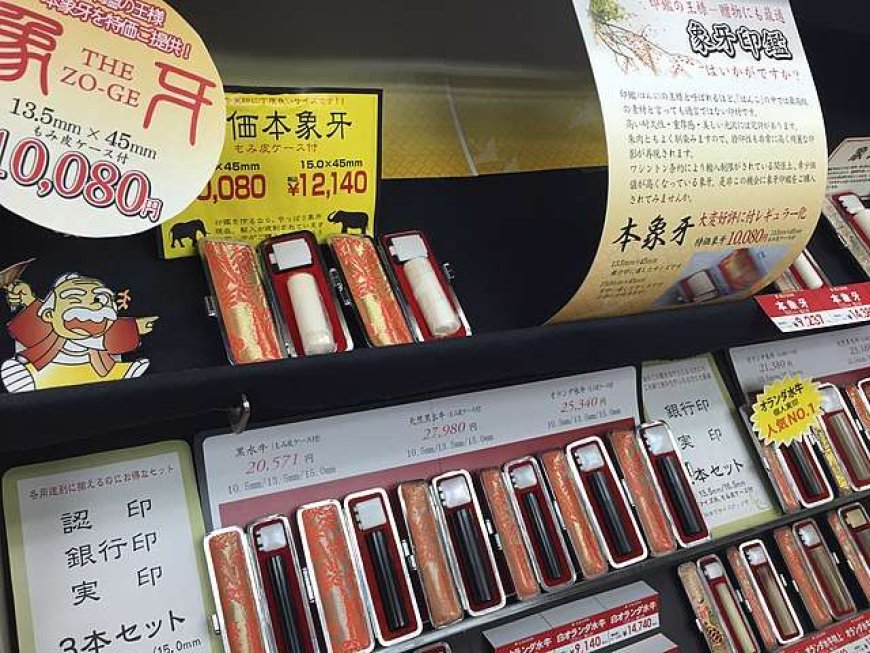Culture of using the Japanese Seal
Unlike many other countries in the world - only companies (legal entities) use seals, in Japan each person (individual) uses a seal (also known as Inkan) instead of the word "Inkan". sign. This is also a cultural feature that surprises many foreigners when they first come to Japan.

History of the seal
The first time stamps were used for political purposes in Japan was in the Nara period, the 8th century. At that time, the government system in Japan was built according to the imperial model of China.
At that time, because the seal was a symbol of the power of the head of the country, only the Emperor used it. The seal is used to confirm the edict issued by the Emperor. It was not until the middle of the 8th century that the nobility in Japan were allowed to use their own seals.
By the Sengoku Warring States period, the 15th century, the history of seals in Japan entered a new phase when warlords waged wars for power, through which the victor was entitled to create his or her own most beautiful seal. , the most iconic.
The popular symbolic images on the seals in this period were dragons, lions, tigers, etc., animals showing power and bravery. This also means that, just by looking at the seal, one knows the power of its owner.
By the Edo period, 17th century, the seal began to be used by the people. Typically, in purchase and sale transactions, merchants use seals to confirm orders and pay bills. Each business has its own seal, so a series of seals with different designs were born.
The shogunate period with the policy of seclusion from the beginning of the 17th century officially ended in 1867, replaced by the Meiji period focusing on developing the country according to the policy of learning Western civilization.
However, the Meiji government did not give up the use of the seal, on the contrary, it was widely disseminated to the entire population. If before, only aristocrats, martial artists or merchants could use their seals, but now everyone has their own seals.
What is Inkan? Other ways of calling Inkan?
Inkan (印鑑), also commonly known as Hanko (ハンコ) is a seal (for legal entities (companies) and for individuals).
Jitsuin (実印) is the name for the registered Inkan.
Ginkoin (銀行印) is the name for Inkan made to be used for banking transactions.
Ninin (認印) is the way to call the Inkans used for normal everyday things like receiving parcels... (non-important things).
The way to call it in Japanese is so complicated because people call it according to the purpose of use of each seal, and in Vietnamese, it's just called the Seal.
Engrave Name or Surname on the seal?
In Japan, personal Inkan is usually made of wood, stone or plastic. If you are a foreigner, you can engrave your First Name or Last Name on your Inkan (provided that your Name/Last Name is in the Alien Registration Form). Due to the culture of using Surname in communication, Japanese people only engrave their Surname written in Kanji on personal Inkan.
When to use Inkan?
Inkan is used in many things, from everyday things such as confirming receipt of letters and parcels to transactions, signing contracts, opening bank accounts… However, not all Inkan can be used for important transactions (such as signing a sales contract, opening a bank account, etc.). For such transactions, you must use a registered Inkan (with the local authority).
Why do the Japanese use a red 6mm round seal when there is a red 9mm seal?
For Japan, they are proud to be the park of the world, which means everything is very clean and the awareness of environmental protection is very good.
Where can I sign up for Inkan? What types of Inkan cannot be registered?
After doing Inkan, if you want to register, you can go to Shiyakusho (市役所) to register. However, not any type of Inkan is allowed to register, so you need to be aware. When you go to Inkan for yourself, you should clearly tell people that you need to do Inkan to open a bank account.
Types of Inkan not allowed to register:
– Inkan is already registered by someone else
– Inkan does not have registered Name or Surname (according to ID or Alien Registration Certificate)
– Inkan made of gum or plastic (easily deformed)
– Inkan is defective, no border or border is defective, incomplete
– Inkan with diameter less than 8mm or greater than 25mm
Inkan certification:
For important transactions such as house purchase contracts, car purchases, bank withdrawals, etc., in addition to Inkan, you are also required to provide an Inkan Confirmation (印鑑証明書). It can be understood that this Inkan Certificate is a registered Inkan. When you register for Inkan at the city government, you will be issued an Inkan Certificate of Registration (印鑑登録書). These two types of paper are different.
Who is allowed to register for Inkan?
If you are a foreigner living in Japan, you can register for Inkan with the following conditions:
- Have a Certificate of Alien Registration
- Over 16 years old
--------------------------
Injavi.com - Visit in Japan
























































































